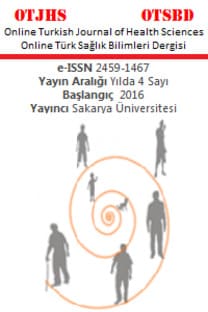Desfluranın Aynı Konsantrasyonda Fakat Farklı Akımlarda Kullanılması Oksidatif Stresi Değiştiştirir mi? Hayvan Deneyi
Desfluran, oksidatif stres, düşük akım, yüksek akım
Does the Application of Desflurane at The Same Concentration by Different Flows Change the Oxidative Stress? Animal Experiment
Desflurane, oxidative stress, low flow, high flow,
___
- Referans1. Noeman SA, Hamooda HE, Baalash AA. Biochemical study of oxidative stress markers in the liver, kidney and heart of high fat diet induced obesity in rats. DiabetolMetabSyndr. 2011 Aug 3;3(1):17.
- Referans2. Zhang W, Liu M, Zang Z, et al. Effect of different anesthesia methods on erythrocyte immune function in mice.Asian Pacific Journal of Tropical Medicine (2013)995-998.
- ReferansReferans3. TürkanH,Aydın A, Sayal A, et al. The effect of sevoflurane and desflurane on markers of oxidative status in erythrocyte. Toxicology and Industrial Health 27(2) 181-186.
- Referans4. Schilling T, Kozlan A, Kretzschmar M, et al. Effects of propofol and desfluraneanaesthesia on the the alveolar inflammatoryy response to one-lung ventilation. Br J Anaesth. 2007;99:368-75.
- Referans5. Wilson JX, Gelb AW. Free Radicals, Antioxidants, and Neurologic Injury: Possible Relationship to Cerebral Protection by Anesthetics. Journal of Neurosurgical Anesthesiology. 2002;14–1:66-79.
- Referans6.Kevin LG, Novalija E, David F. Reactive Oxygen Species as Mediators of Cardiac Injury and Protection: The Relevance to Anesthesia Practice. Anesthesia & Analgesia. 2005;101-5:1275-1287.
- Referans7.Zülfikaroğlu B, Koç M, Soran A, Isman FK, Cinel İ. Evaluation of oxidative stress in laparoscopic cholecystectomy. Surg Today 2002;32:869–874.
- Referans8. Garg N, Singh R, Dixit J, Jain A, Tewari V. Levels of lipid peroxides and antioxidants in smokers and nonsmokers. J Periodontal Res 2006;41:405-10.
- Referans9. Sivaci R, Kahraman A, Serteser M, Sahin DA, Dilek ON. Cytotoxic effects of volatile anesthetics with free radicals undergoing laparoscopic surgery.ClinBiochem 2006;39:293–298.
- Referans10. Allaouchiche B, Debon R, Goudable J, Chassard D, Duflo F. Oxidative stress status during exposure to propofol, sevoflurane and desflurane. AnesthAnalg. 2001; 93: 981-5.
- Referans11.Koksal GM, Sayilgan C, Aydin S, Uzun H, Oz H . The effects of sevoflurane and desflurane on lipid peroxidation during laparoscopic cholecystectomy. March 2004;21(3);217-220.
- Referans12. Halliwell B, Chirico S. Lipid peroxidation: its mechanism, measurement, and significance. Am J ClinNutr 1993;57(5):715-24.
- Referans13. Yu BP. Cellular defenses against damage from reactive oxygen species. Physiol Rev 1994;74(1):139-62.
- Referans14. AsimetrikDimetilArjinin (ADMA) MetabolizmasıInt J Basic Clin Med 2013;1(1):61-66.
- Referans15. Matsuguma K, Ueda S, Yamagishi S, Matsumoto Y, Kaneyuki U, Shibata R, Fujimura T, Matsuoka H, Kimoto M, Kato S, Imaizumi T, Okuda S. Molecular mechanism for elevation of asymmetric dimethylarginine and its role for hypertension in chronic kidney disease. J Am SocNephrol 2006;17(8): 2176-83.
- Referans16. Ames B.N., Shigenara M.K, “DNA damage by Endogenous oxsidants and mithogenesis As Causes of Aging and Cancer” Molecular Biology of free radical scavenging systems, ed, scandalios, J.G. (Cold Spring Harbor LaboratuaryPres, Plainviev .p:1-21) (1992)
- Referans17.Brueckl C, Kaestle S, Kerem A, Habazettl H, Krombach F, Kuppe H, Kuebler WM. Hyperoxia-induced reactive oxygen species formation in pulmonary capillary endothelial cells in situ. Am J Respir Cell Mol Biol. 2006;34:453–63.
- Referans18. Fessel JP, Flynn CR, Robinson LJ, Penner NL, Gladson S, Kang CJ, Wasserman DH, Hemnes AR, West JD. Hyperoxia synergizes with mutant bone morphogenic protein receptor 2 to cause metabolic stress, oxidant injury, and pulmonary hypertension. Am J Respir Cell Mol Biol. 2013;49:778–87.
- Referans19. Stoner JD, Clanton TL, Aune SE, Angelos MG. O2 delivery and redox state are determinants of compartment-specific reactive O2 species in myocardial reperfusion. Am J Physiol Heart Circ Physiol. 2007;292:H109–16.
- ISSN: 2459-1467
- Yayın Aralığı: Yılda 4 Sayı
- Başlangıç: 2016
- Yayıncı: Oğuz KARABAY
Evde Bakım Birimince Takip Edilen Hastaların Bakımlarından Sorumlu Kişilerde Depresyon
Serkan TOKER, Arzu AYRALER, Rahime ÖZGÜR
Kas İskelet Sistemi Yakınması Olmayan Osteoartiküler Bruselloz
Ertuğrul GUCLU, Yusuf DURMAZ, Oğuz KARABAY
Sakarya İlinde Hepatit C Virüs Genotip Dağılımı; Üç Yıllık Retrospektif Çalışma
Semra ÖZ, Mehmet KÖROĞLU, Ahmet ÖZBEK, Tayfur DEMİRAY, Oğuz KARABAY, Gülay TRAK, Mustafa ALTINDİŞ
Testis Torsiyonu ile Ortalama Trombosit Hacminin İlişkisi
Apendiks Tümörlerinin İnsidansı, Tedavisi ve Sağ Kalım: Retrospektif Bir Çalışma
Servet KOCAÖZ, Emin GEMCIOĞLU, Abdurrezzak YILMAZ, Aydan KILIÇARSLAN, Ömer PARLAK
Halime Hanım PENÇE, Hanife Şerife AKTAŞ
Almanya'da Yaşayan Türk Göçmenlerin Ruh Sağlığının Değerlendirilmesi
Murat Eren OZEN, Gulumser PELTEK, Mehmet Hamdi ORUM, Aysun KALENDEROGLU, Salih SELEK
Çiğdem ÜNAL KANTEKIN, Müge ÇAKIRCA, Ferda YAMAN, Ayşe Yeşim GÖÇMEN
Multipl Skleroz Erken Tanısında Ses Analizi Yönteminin Kullanılabilirliğinin İncelenmesi
Zeynep Zeliha BAYAZIT, Ali Rıza SONKAYA
